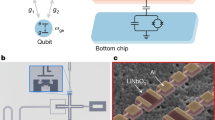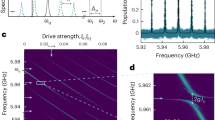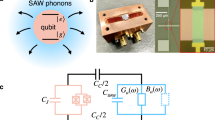Abstract
Mechanical resonators are emerging as an important new platform for quantum science and technologies. A large number of proposals for using them to store, process and transduce quantum information motivates the development of increasingly sophisticated techniques for controlling mechanical motion in the quantum regime. By interfacing mechanical resonators with superconducting circuits, circuit quantum acoustodynamics can make a variety of important tools available for manipulating and measuring motional quantum states. Here we demonstrate the direct measurements of phonon number distribution and parity of non-classical mechanical states. We do this by operating our system in the strong dispersive regime, where a superconducting qubit can be used to spectroscopically resolve the phonon Fock states. These measurements are some of the basic building blocks for constructing acoustic quantum memories and processors. Furthermore, our results open the door for performing even more complex quantum algorithms using mechanical systems, such as quantum error correction and multimode operations.
This is a preview of subscription content, access via your institution
Access options
Access Nature and 54 other Nature Portfolio journals
Get Nature+, our best-value online-access subscription
$29.99 / 30 days
cancel any time
Subscribe to this journal
Receive 12 print issues and online access
$209.00 per year
only $17.42 per issue
Buy this article
- Purchase on Springer Link
- Instant access to full article PDF
Prices may be subject to local taxes which are calculated during checkout




Similar content being viewed by others
Data availability
Source data are provided with this paper. All other data that support the plots within this paper and other findings of this study are available from the corresponding authors upon reasonable request.
Code availability
Analysis and simulation codes that support the findings of this study are available from the corresponding authors upon reasonable request.
References
Chu, Y. et al. Creation and control of multi-phonon Fock states in a bulk acoustic-wave resonator. Nature 563, 666–670 (2018).
Bienfait, A. et al. Quantum erasure using entangled surface acoustic phonons. Phys. Rev. X 10, 021055 (2020).
Arrangoiz-Arriola, P. et al. Resolving the energy levels of a nanomechanical oscillator. Nature 571, 537–540 (2019).
Sletten, L. R., Moores, B. A., Viennot, J. J. & Lehnert, K. W. Resolving phonon Fock states in a multimode cavity with a double-slit qubit. Phys. Rev. X 9, 021056 (2019).
Kotler, S. et al. Direct observation of deterministic macroscopic entanglement. Science 372, 622–625 (2021).
Ockeloen-Korppi, C. F. et al. Stabilized entanglement of massive mechanical oscillators. Nature 556, 478–482 (2018).
MacCabe, G. S. et al. Nano-acoustic resonator with ultralong phonon lifetime. Science 370, 840–843 (2020).
Tsaturyan, Y., Barg, A., Polzik, E. S. & Schliesser, A. Ultracoherent nanomechanical resonators via soft clamping and dissipation dilution. Nat. Nanotechnol. 12, 776–783 (2017).
Chamberland, C. et al. Building a fault-tolerant quantum computer using concatenated cat codes. PRX Quantum 3, 010329 (2022).
Pikovski, I., Vanner, M. R., Aspelmeyer, M., Kim, M. S. & Brukner, Č. Probing Planck-scale physics with quantum optics. Nat. Phys. 8, 393–397 (2012).
Bertet, P. et al. Direct measurement of the Wigner function of a one-photon Fock state in a cavity. Phys. Rev. Lett. 89, 200402 (2002).
Schuster, D. I. et al. Resolving photon number states in a superconducting circuit. Nature 445, 515–518 (2007).
Walter, T. et al. Rapid high-fidelity single-shot dispersive readout of superconducting qubits. Phys. Rev. Appl. 7, 054020 (2017).
Rosenblum, S. et al. Fault-tolerant detection of a quantum error. Science 361, 266–270 (2018).
Ofek, N. et al. Extending the lifetime of a quantum bit with error correction in superconducting circuits. Nature 536, 441–445 (2016).
Hu, L. et al. Quantum error correction and universal gate set operation on a binomial bosonic logical qubit. Nat. Phys. 15, 503–508 (2019).
Chu, Y. & Gröblacher, S. A perspective on hybrid quantum opto- and electromechanical systems. Appl. Phys. Lett. 117, 150503 (2020).
Chu, Y. et al. Quantum acoustics with superconducting qubits. Science 358, 199–202 (2017).
Satzinger, K. J. et al. Simple non-galvanic flip-chip integration method for hybrid quantum systems. Appl. Phys. Lett. 114, 173501 (2019).
Blais, A., Huang, R.-S., Wallraff, A., Girvin, S. M. & Schoelkopf, R. J. Cavity quantum electrodynamics for superconducting electrical circuits: an architecture for quantum computation. Phys. Rev. A 69, 062320 (2004).
Koch, J. et al. Charge-insensitive qubit design derived from the Cooper pair box. Phys. Rev. A 76, 042319 (2007).
Krantz, P. et al. A quantum engineer’s guide to superconducting qubits. Appl. Phys. Rev. 6, 021318 (2019).
Blais, A., Grimsmo, A. L., Girvin, S. M. & Wallraff, A. Circuit quantum electrodynamics. Rev. Mod. Phys. 93, 025005 (2021).
Sun, L. et al. Tracking photon jumps with repeated quantum non-demolition parity measurements. Nature 511, 444–448 (2014).
Royer, A. Wigner function as the expectation value of a parity operator. Phys. Rev. A 15, 449–450 (1977).
Burnett, J. J. et al. Decoherence benchmarking of superconducting qubits. npj Quantum Inf. 5, 54 (2019).
Johansson, J. R., Nation, P. D. & Nori, F. QuTiP: an open-source Python framework for the dynamics of open quantum systems. Comput. Phys. Commun. 183, 1760–1772 (2012).
Pechal, M., Arrangoiz-Arriola, P. & Safavi-Naeini, A. H. Superconducting circuit quantum computing with nanomechanical resonators as storage. Quantum Sci. Technol. 4, 015006 (2019).
Hann, C. T. et al. Hardware-efficient quantum random access memory with hybrid quantum acoustic systems. Phys. Rev. Lett. 123, 250501 (2019).
McCormick, K. C. et al. Quantum-enhanced sensing of a single-ion mechanical oscillator. Nature 572, 86–90 (2019).
Penrose, R. On gravity’s role in quantum state reduction. Gen. Relat. Gravit. 28, 581–600 (1996).
Vlastakis, B. et al. Deterministically encoding quantum information using 100-photon Schrödinger cat states. Science 342, 607–610 (2013).
Heeres, R. W. et al. Implementing a universal gate set on a logical qubit encoded in an oscillator. Nat. Commun. 8, 94 (2017).
Gao, Y. Y. et al. Entanglement of bosonic modes through an engineered exchange interaction. Nature 566, 509–512 (2019).
Leghtas, Z. et al. Confining the state of light to a quantum manifold by engineered two-photon loss. Science 347, 853–857 (2015).
Acknowledgements
We thank X. Cao and A. deMello for help with the flip-chip-bonding process and J.-C. Besse for help with the qubit fabrication. We thank B. Li for providing support with the QuTiP simulations. The fabrication of devices was performed at the FIRST cleanroom of ETH Zürich and the BRNC cleanroom of IBM Zürich. M.F. acknowledge The Branco Weiss Fellowship—Society in Science, administered by the ETH Zürich.
Author information
Authors and Affiliations
Contributions
U.v.L. and L.M. designed and fabricated the device. U.v.L. and M.B. constructed the parametric amplifier used for the qubit readout. M.B. wrote the experiment control software. Y.Y., U.v.L. and M.B. performed the experiment and analysed the data. Y.Y. performed the QuTiP simulations of the experiment. M.F., M.B. and Y.C. performed the theoretical calculations. Y.C. supervised the work. U.v.L., Y.Y., M.B., M.F. and Y.C. wrote the manuscript.
Corresponding authors
Ethics declarations
Competing interests
The authors declare no competing interests.
Peer review
Peer review information
Nature Physics thanks the anonymous reviewers for their contribution to the peer review of this work.
Additional information
Publisher’s note Springer Nature remains neutral with regard to jurisdictional claims in published maps and institutional affiliations.
Supplementary information
Supplementary Information
Supplementary Table 1, Figs. 1–6 and Sections A–G.
Source data
Source Data Fig. 1
Source data for Fig. 1d.
Source Data Fig. 2
Source data for Fig. 2 (one tab for each subfigure).
Source Data Fig. 3
Source ata for Fig. 3 (one tab for each subfigure).
Source Data Fig. 4
Source ata for Fig. 4d.
Rights and permissions
About this article
Cite this article
von Lüpke, U., Yang, Y., Bild, M. et al. Parity measurement in the strong dispersive regime of circuit quantum acoustodynamics. Nat. Phys. 18, 794–799 (2022). https://doi.org/10.1038/s41567-022-01591-2
Received:
Accepted:
Published:
Issue Date:
DOI: https://doi.org/10.1038/s41567-022-01591-2
This article is cited by
-
Engineering multimode interactions in circuit quantum acoustodynamics
Nature Physics (2024)
-
A quantum electromechanical interface for long-lived phonons
Nature Physics (2023)
-
Two-level system hyperpolarization using a quantum Szilard engine
Nature Physics (2023)
-
Phononic bath engineering of a superconducting qubit
Nature Communications (2023)
-
Fast generation of Schrödinger cat states using a Kerr-tunable superconducting resonator
Nature Communications (2023)



